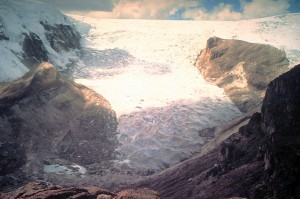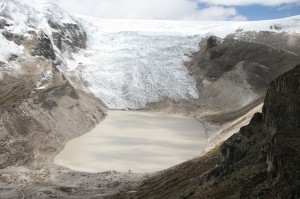A Millennium And A Half Of Ice Melted In 25 Years
 Ice that took 1,600 years to form in the Andes has melted in 25 years: “the latest indication that the recent spike in global temperatures has thrown the natural world out of balance.”
Ice that took 1,600 years to form in the Andes has melted in 25 years: “the latest indication that the recent spike in global temperatures has thrown the natural world out of balance.” Lonnie G. Thompson, the Ohio State University glaciologist whose team has worked intermittently on the Quelccaya ice cap for decades, reported the findings in a paper released online Thursday by the journal Science….
Throughout the Andes, glaciers are now melting so rapidly that scientists have grown deeply concerned about water supplies for the people living there. Glacial meltwater is essential for helping Andean communities get through the dry season.
In the short run, the melting is producing an increase of water supplies and feeding population growth in major cities of the Andes, the experts said. But as the glaciers continue shrinking, trouble almost certainly looms.

Douglas R. Hardy, a University of Massachusetts researcher who works in the region, said, “How much time do we have before 50 percent of Lima’s or La Paz’s water resources are gone?”
See also Lonnie Thompson on why climatologists are speaking out: “Virtually all of us are now convinced that global warming poses a clear and present danger to civilization.”
THE GOOD
New White House Chief of Staff Denis McDonough recognizes climate change is a serious problem and is expected to have a big impact on executive decisions. [National Journal]
Energy-related carbon dioxide emissions in 2012 were the lowest since 1994. [Energy Information Administration]
California regulators are considering a crackdown on fracking, with increased emissions monitoring and advance notice of drilling. [National Journal]
New rules from the Interior Department increase workplace safety regulations on offshore drilling platforms following the 2010 BP Deepwater Horizon spill. [The Hill]
The Air Force released a strategic energy plan that aims to increase its renewable energy consumption from 5 percent to 25 percent. [Sustainable Business]
Japan could be the world’s second-largest solar market after China this year. [Sustainable Business]
THE BAD
After Superstorm Sandy, the National Hurricane Center will now continue to issue warnings and advisories when extremely strong storms stop being hurricanes, but still pose threats to coastal areas. [AP]
The Exxon Pegasus pipeline spill reminds us that we “still rely on the ready abundance of a volatile, toxic sludge.” [Washington Post]
The largest processor of petroleum products in the United States is half owned by Saudi Aramco, in Prot Arthur, Texas. [New York Times]
BP is selling its wind energy assets to refocus on petroleum. [Christian Science Monitor]
AND THE UGLY
Scientists at the University of South Florida say the oil from the Deepwater Horizon spill caused a die-off in the millions at the bottom of the aquatic food chain. [Tampa Bay Tribune]
Growing pools of toxic green algae in the Great Lakes have agriculture practices and global warming to thank. [Atlantic Cities]
A new report from NOAA found that extreme precipitation from intense storms will increase significantly this century in the U.S. [LA Times]
You can return to the main Market News page, or press the Back button on your browser.

